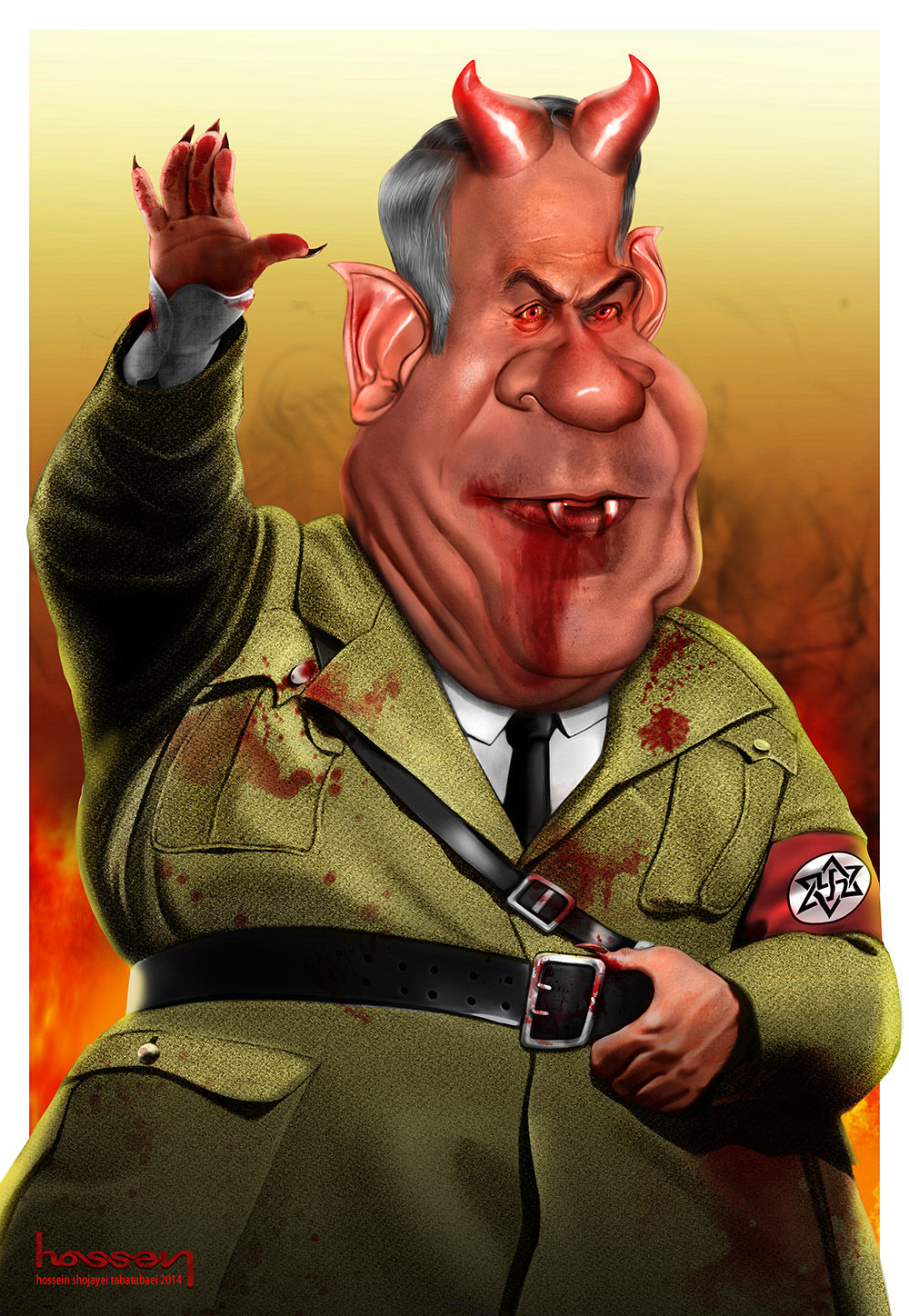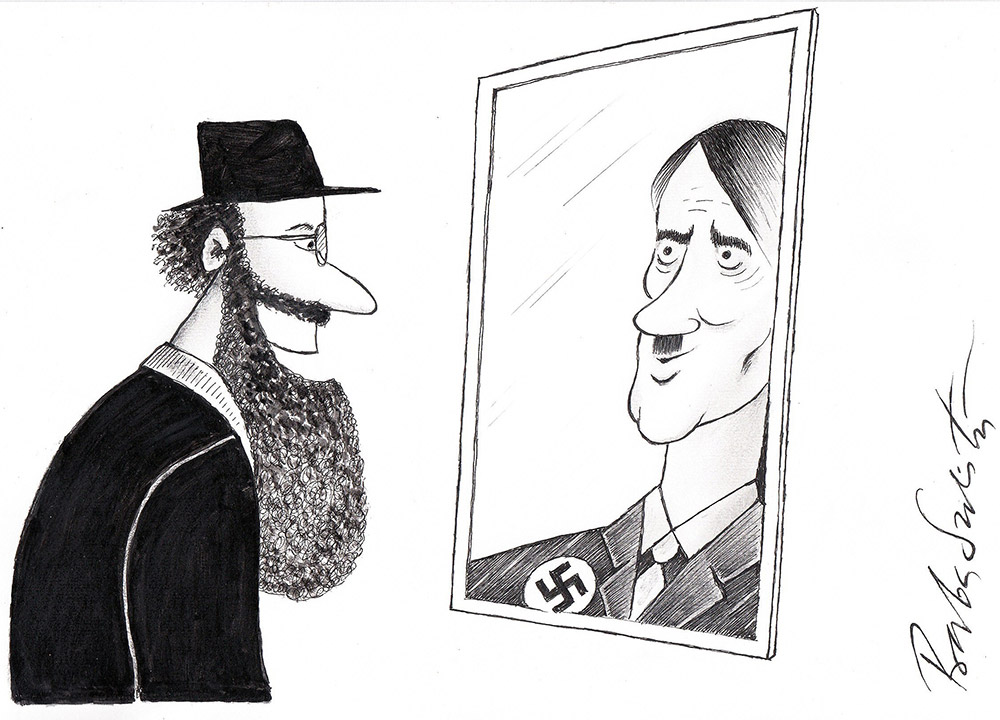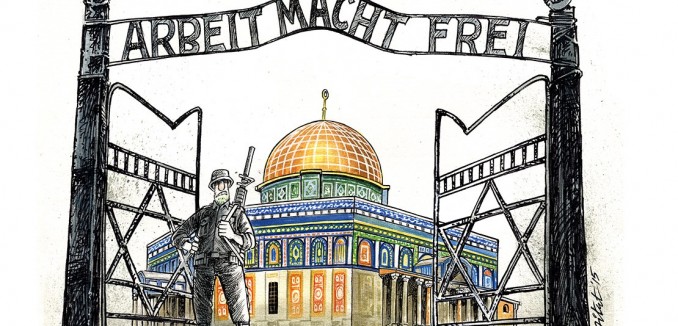JNS.org – A haredi Jew looks into a mirror and sees the face of Adolf Hitler gazing back at him. The walls and guard towers of Auschwitz are squeezed into a snow shaker, with flying dollar bills replacing the fake snowflakes. Another haredi Jew waves a swastika-shaped fan at an Israeli flag, which blows furiously atop a corpse draped in a Palestinian flag.
Not enough? There’s more. The gates of Auschwitz, adorned with the deadly motto “Arbeit Macht Frei,” swing open to reveal the Al-Aqsa mosque, which sits on Jerusalem’s Temple Mount. Israeli Prime Minister Benjamin Netanyahu, devils’ horns jutting from his forehead, gives a Nazi salute; instead of his usual business suit, he wears a bloodstained brown uniform, with a Star of David rendered as a swastika decorating the sleeve.
 These are just a selection of the entries submitted to Iran’s latest Holocaust cartoon contest, currently on display in Tehran at the none-too-subtly named Islamic Propaganda Organization. By and large, the cartoons are crudely drawn, in keeping with the themes that they promote.
These are just a selection of the entries submitted to Iran’s latest Holocaust cartoon contest, currently on display in Tehran at the none-too-subtly named Islamic Propaganda Organization. By and large, the cartoons are crudely drawn, in keeping with the themes that they promote.
Yet I have to confess to being more bored than shocked. Such imagery is hardly new, after all. The depictions of Jews in this exhibit are straight out of Nazi propaganda, while the depiction of the State of Israel as Hitler’s inheritor was pushed by the Soviet Union for almost half a century. The Islamist barbarians who run Iran may be many things, but creators of pathbreaking art they are definitely not.
As fashionable as it is in President Barack Obama’s circle to pretend that the Iranian regime is in the throes of dramatic change, with a surging “moderate” wing that wants to engage the West, this latest cartoon contest—like last year’s contest, like the first cartoon contest in 2005, and like the conference of Holocaust deniers convened in 2006—demonstrates that the mullahs cannot kick their enduring pathology: striking a blow at the global Jewish conspiracy by wiping Israel off the map.
 Even if we accept for the sake of argument that the regime can be simply bifurcated into “moderates” and “hardliners,” those Iranian leaders identified in the West as “moderates” come out of this latest cartoon scandal looking far shabbier than their “hardline” rivals. Recall that Iran’s “hardline” supreme leader, Ayatollah Ali Khamenei, chose Holocaust Remembrance Day to question whether the slaughter of 6 million Jews had in fact occurred. The cartoon contest, backed to the hilt by the regime, is the natural outgrowth of Iran’s state policy of anti-Semitism, which holds that the Holocaust is a myth shamelessly used by the Jewish state to garner world sympathy. Khamenei and his cohorts, who are structurally and politically at the center of power in Iran, are quite open about all this and don’t feel the need to rationalize or excuse the state-sponsored mockery of the genocide of Jews.
Even if we accept for the sake of argument that the regime can be simply bifurcated into “moderates” and “hardliners,” those Iranian leaders identified in the West as “moderates” come out of this latest cartoon scandal looking far shabbier than their “hardline” rivals. Recall that Iran’s “hardline” supreme leader, Ayatollah Ali Khamenei, chose Holocaust Remembrance Day to question whether the slaughter of 6 million Jews had in fact occurred. The cartoon contest, backed to the hilt by the regime, is the natural outgrowth of Iran’s state policy of anti-Semitism, which holds that the Holocaust is a myth shamelessly used by the Jewish state to garner world sympathy. Khamenei and his cohorts, who are structurally and politically at the center of power in Iran, are quite open about all this and don’t feel the need to rationalize or excuse the state-sponsored mockery of the genocide of Jews.
Not so with Iranian Foreign Minister Mohammad Javad Zarif, whose detestation of Israel doesn’t blind him to the fact that the countries he flirts with, like Germany, take a dim view of Iran’s Holocaust denial antics. But unlike the “hardliners,” who are disarmingly honest about their views on the Jewish people and their desire to eliminate Israel, Zarif speaks with a forked tongue.
That shouldn’t mask the fact that Zarif is both a coward, since he refuses to condemn the cartoon contest, and a liar, since he insists that the regime he represents has nothing to do with it. Speaking to The New Yorker, Zarif clucked, “Don’t consider Iran a monolith. The Iranian government does not support, nor does it organize, any cartoon festival of the nature that you’re talking about.” That claim is about as truthful as the Obama administration’s reassurance that the nuclear deal struck with Tehran will prevent the regime from developing nuclear weapons. In other words, it isn’t at all.
 No doubt, there are those who will take Zarif at face value, and perhaps even laud the fact that, by his account, artists exhibiting in Iran have creative license unfettered by government restrictions—so long, that is, as their subject is the Holocaust. For those not seduced by wishful thinking, there is the cold reality that the cartoon exhibit is completely dependent upon regime support. As the Iranian writer Majid Mohammadi pointed out in a detailed briefing published by the U.S. Holocaust Memorial Museum, the institutions involved in the exhibit are “all organized, financed, and managed under the supreme leader’s office, his appointed bodies, and the executive branch headed by the president. There are no private or independent nongovernmental institutions active in this area. The government and its varied set of institutions are the only ones that pay for these types of ideologically oriented activities. There is no channel for private funds, and no provision in Iran’s tax code, to support these activities.”
No doubt, there are those who will take Zarif at face value, and perhaps even laud the fact that, by his account, artists exhibiting in Iran have creative license unfettered by government restrictions—so long, that is, as their subject is the Holocaust. For those not seduced by wishful thinking, there is the cold reality that the cartoon exhibit is completely dependent upon regime support. As the Iranian writer Majid Mohammadi pointed out in a detailed briefing published by the U.S. Holocaust Memorial Museum, the institutions involved in the exhibit are “all organized, financed, and managed under the supreme leader’s office, his appointed bodies, and the executive branch headed by the president. There are no private or independent nongovernmental institutions active in this area. The government and its varied set of institutions are the only ones that pay for these types of ideologically oriented activities. There is no channel for private funds, and no provision in Iran’s tax code, to support these activities.”
Why engage in such an activity in the first place? “The Islamic Republic seeks to be the most prominent global voice of antisemitic and anti-Israel sentiment and in doing so has made connections with and promoted individuals espousing these views from across the world,” Mohammadi says. “The Holocaust is just a subject of a set of cartoons in this effort.”
 This is not a recent development, nor is it related to Israeli policy or anything Israel actually does. Anti-Semitism among Iran’s Islamists in fact precedes the creation of the State of Israel. In his excellent book “Germany and Iran: From the Aryan Axis to the Nuclear Threshold,” German historian Matthias Kuentzel described the massive audience in Iran for Radio Zeesen, a Nazi propaganda outlet that broadcasted programming in Farsi. Among the listeners was the figurehead of Iranian Islamism, Ayatollah Ruhollah Khomeini. According to Kuentzel, Khomeini was an enthusiastic “connoisseur” of European anti-Semitism. “They are liars and determined,” Khomeini wrote in a tract entitled “The Islamic State.” There was also the following claim, based on the same wretched fantasies that lead to Holocaust denial: “We see today that the Jews (may God curse them) have meddled with the text of the Qur’an and have made certain changes in the Qur’ans they have printed in the occupied territories.”
This is not a recent development, nor is it related to Israeli policy or anything Israel actually does. Anti-Semitism among Iran’s Islamists in fact precedes the creation of the State of Israel. In his excellent book “Germany and Iran: From the Aryan Axis to the Nuclear Threshold,” German historian Matthias Kuentzel described the massive audience in Iran for Radio Zeesen, a Nazi propaganda outlet that broadcasted programming in Farsi. Among the listeners was the figurehead of Iranian Islamism, Ayatollah Ruhollah Khomeini. According to Kuentzel, Khomeini was an enthusiastic “connoisseur” of European anti-Semitism. “They are liars and determined,” Khomeini wrote in a tract entitled “The Islamic State.” There was also the following claim, based on the same wretched fantasies that lead to Holocaust denial: “We see today that the Jews (may God curse them) have meddled with the text of the Qur’an and have made certain changes in the Qur’ans they have printed in the occupied territories.”
These same views prevail among Iran’s leaders today, no matter what Zarif says. Indeed, to disavow Khomeini would be unthinkable in the current context, as demonstrated by the recent election of Ayatollah Ahmed Jannati as head of the “Assembly of Experts,” a key ruling body that chooses the supreme leader.
Jannati is a boilerplate fanatic who leads chants of “Death to America” and “Death to Israel” at Friday prayers. It was Jannati who, in 2009, backed then president Mahmoud Ahmadinejad’s blood-drenched crackdown against pro-democracy demonstrators. The regime that existed in 2009 still exists today, with the same mechanisms of fearsome repression at its disposal. It cannot be reformed, and certainly not from within. But—heretical as it is to say this—it can, and should, be overthrown.
Ben Cohen is a Senior Editor at The Tower Magazine and the Director of Partnership Programs at The Israel Project. Publications he has written for include Commentary, The Wall Street Journal, Ha’aretz and Tablet. He writes a weekly column for JNS.org, a news agency serving the Jewish media. Follow him on Twitter @BenCohenOpinion.




